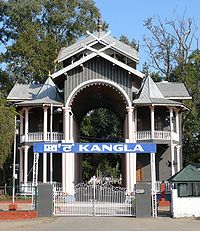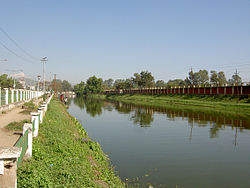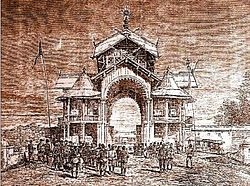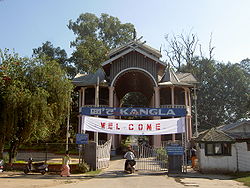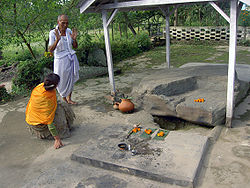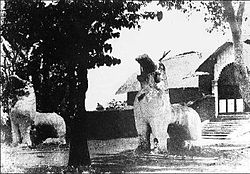- Kangla Palace
-
The Palace of Bangla is an old palace at Kangla in the Manipur state of India. It was situated on both sides (western and eastern) of the bank of the Imphal River. But now it remains only on the western side of the bank. Only the ruins remain now. Kangla means "dry land" in old Meitei. It was the traditional seat of the past Meitei rulers of Manipur. The British referred to it as the Jaipur Fort.
Introduction
'Kangla' was the ancient capital of Manipur from the ancient times down to the year 1891 AD. It is located at the heart of the Imphal city almost intersected by 24°N Latitude, 94°E Longitude and it is 2,619 feet (798 m) above mean sea level. It is situated on the western bank of the Imphal River.
In ancient times, 'angla' was the royal palace since the reign of Pakhangba who ascended the throne in 33 AD, according to "Cheitharol Kummaba", the royal Chronicle of Manipur.
In pre-Pakhangba period, a ruling clan named Khaba ruled from 'Kangla'. 'Kangla' is not only the seat of political power but also a holy place for religious worship and ceremonies. There are a number of ancient treaties/manuscripts especially "Sakoklamlen" "Chinglon Laihui", "Nunglon" etc., which lay down the rules for the construction, worship, ceremonies relating to 'Kangla'.
Historical and archeological significance
Kangla is the most important historical and archeological site of Manipur. The kingdom of Manipur was established and developed at Kangla. Being a site of political and religious centre, Kangla has grown into a formidable fortress city through the centuries. It is from this capital that the Ningthouja clan gradually wielded enough political and military power and grew up to be the most dominant clan in Manipur. The royal chronicle gives many references to the construction of Kangla by successive reigning kings in Manipur.
The major landmarks in the growth of Kangla Fort were constructed by King Khagemba (1597–1652 AD), the conqueror of the Chinese. The royal chronicle records that in 1632 AD, Khagemba constructed a brick wall at the western gate of Kangla Fort. It appears that the art of brickmaking was acquired from the Chinese prisoners who were captured during the Chinese invasion of the eastern frontier of Manipur. Khagemba's son Khunjaoba (1632–1666 AD) improved on the fortification and beautification work of Kangla Fort. It is said that the king excavated a moat (Thangapat) on the western side of the Fort. During his period, the power and prestige of Manipur was at its peak. Burmese kings/chiefs approached him to settle their disputes and beg the hands of Manipuri princesses. The Fort was further improved and enlarged by King Garibaniwaz and after him by successive kings of Manipur.
Since the reign of Maharaja Bhagyachandra (1762–1798 AD), due to repeated invasion by the Burmese, Kangla was deserted several times. Maharaj Gambhir Singh, with the help of the Manipur Levy, liberated Manipur from the hands of the Burmese invading forces which occupied Manipur for seven years. This period of Burmese Rule is known as "Chahi Taret Khuntakpa" (Seven Years Devastation) in the annals of Manipur. Gambhir Singh, however, established his capital at Langthabal which is now known as Canchipur. During the reign of Nara Singh, the capital was shifted to Kangla in 1844.
Anglo-Manipur War of 1891
King Chandrakriti was succeeded by his eldest son Surchandra. However, he could not control his step brothers. As a result, Senapati Tikendrajit revolted against him and put his own brother Yubaraj Kulachandra to the Throne of Manipur. By this time, the Britishers took advantage to intervene in the internal affairs of Manipur. They sent Mr. J.W. Quinton, the Chief Commissioner of Assam to negotiate the palace revolt and to exile Senapati Tikendrajit. Thus, the first battle of the Anglo-Manipur War of 1891 broke-out when the British forces, under orders from Mr. J.W. Quinton, the Chief Commissioner of Assam, attacked on 'Kangla', the Manipur Fort in the early hours of 24 March 1891.
Manipur was an independent Asiatic power in alliance with the British Sovereign. This undeclared aggression left the Manipuris infuriated. However, they agreed to negotiate with the British officials when approached. The negotiation failed and the Manipuri commander ordered to execute the British Officers, though the King asked to keep them as prisoners. Thereafter, the British Empire declared war against Manipur and attacked it from three sides i.e., Silchar, Kohima and Tamu (in Myanmar). They conquered 'Kangla Fort' on the 27th April, 1891. Yubaraj Tikendrajit and Thangal General etc., were publicly executed by the British. Since then, 'Kangla' has been under occupation by the Security forces/Assam Rifles.
Holy/Sacred places of Kangla
'Kangla' is regarded as the holiest place for the Manipuris. It is a centre of pilgrimage for all the Manipuris who are residing in Manipur, Assam, Bengal, Uttar Pradesh, Bangladesh and Myanmar etc. It is believed that Lord Pakhangba resides under 'Kangla' and ruled the Kingdom of Manipur and the Universe. It is also believed that there are 360 important holy/sacred places in 'Kangla'. Some of the important holy places in 'Kangla' are:
Nungjeng Pukhri and other ponds
This is a sacred pond believed to be the abode of Lord Pakhangba. It is located to the north-west of the "Uttra". Religious rituals are performed here. Besides this, there are other holy ponds like "Chingkhei Nungjeng", "Manung Nungjeng" and "Lai Pukhri" etc.
Nunggoibi
The site is a sacred place of worship of the Goddess of War. The "Huyein Lalu Chanba" ritual was performed here, whenever a King of Manipur emerged victorious in battle.
Manglen
It is the cremation site of the Kings of Manipur. The "Manglen" is believed to have been developed by Maharaj Garibaniwaz in 1738 AD. According to the royal chronicle, the Cheitharol Kumbaba, Nara Singh Maharaj (1844 - 50 AD) was cremated here at the "Manglen".
Kangla Men Surung
This is a sacred place where the kings of Manipur performed their coronation ceremony/erat-thouni. It is believed that the king will be able to rule the state or not according to the results of the ceremony/erat-thouni.
Site of Lord Wangbaren
This is located to the southeastern corner of 'Kangla' where ceremony/erat-thouni were performed in connection with flood and natural calamities.
Site for Lord Koubru
It is located to the northwestern corner of 'Kangla' and is worshipped mainly for good rainfall etc.
Besides these holy/sacred places, there are "Paotak Pung", "Pakhangba Pung", "Pakhangba Khuda", "Nata Pung", "Yaorei Khukal Tetnou Yotli Chingba Ching", "Yaoreibi" "Yaichampat", "Lukhrapat", the site of "Mangang Guru", "Shumshang", "Yumjaolairenbi", "Lai-Nongshaba", etc.
Monuments & Archaeological sites in Kangla Fort
Ruins of the Citadel
Cheitharol Kumbaba, the royal chronicle, records the construction of the Citadel in the year 1611 AD, that is, during the reign of King Khagemba (1597 - 1652 AD). Twenty feet high, the Citadel is built of well-burnt bricks. A number of sacred places, including the coronation site of Pakhangba, were located within the enclosure of the citadel. The citadel enclosure had three entrances, two on the western side and one on the southern side. The entrance on the left end of the western face was opposite to the coronation hall and the entrance to the right end of the same wall faced the Darbar Hall. The southern entrance was connected with the passage leading to the Shree - Shree Govindajee Temple.
Ruins of the Uttra
The "Uttra" is the ancestral coronation hall of the Manipur kings. The installation ceremonies took place here. The building housing the coronation hall was destroyed in air raids during the Second World War The flight of the steps and the ruins of the foundation are the only remains of the "Uttra".
Site of the two 'Kangla Sha' (Dragon)
Two huge 'Kangla Sha' (Dragons) made of brick used to stand in front of the "Uttra" but just beyond the flight of steps leading to the "Uttra" - on either side of the path leading to the "Uttra". Mr. T.C. Hudson wrote in his book/The Meitheis', that the dragon was the National Emblem of the Meiteis. According to Sir James Johnstone, these dragons were originally erected by the Chinese war captives. 'Kangla Sha' were blown to pieces by the British after their occupation of 'Kangla' Fort in 1891. The site is remembered historically as the place where four British officers were beheaded by the Manipuri soldiers.
Temple of Shree - Shree Govindajee
The temple of Shree - Shree Govindajee was originally built in 1846 AD, that is, during the reign of Maharaja Nara Singh (1844 - 50 AD). It was severely damaged in the great earthquake of 1868 AD. The deities(murtis) of Radha Govinda was damaged when parts of the temple collapsed in the earthquake (Cheitharol Kumbaba, p. 375). Maharaj Chandrakriti (1859 -86 AD), the then ruler of Manipur, reconstructed the temple in its original form. The temple is dedicated to Lord Govinda and His consort Radha.
Stone Inscription
There is a stone inscription belonging to the period of Maharaja Marjit.
Important structures of the British/Post Independence period
There are many important historical and Architectural buildings/structures which belong to the British and post-independence period viz.:
- Field Marshal General Slim's Cottage - the famous General of Second World War
- Unit Hospital of the Assam Rifles.
- Sir Akbar Hydri's tomb - the Governor of Assam.
- Residence/Bungalows of the British Officers/Assam Rifle Officers,
- Samadhi of Maharaj Bodhachandra of Manipur etc.
- Memorial Stone at Kekrupat, which was erected in memory of those who sacrificed their life during the historic event of June 18, 2002.
- The 1st I.R.B. Memorial.
- 17 Assam Rifle Commandants Office.
Concept Development Plan (CDP) of 'Kangla' Fort Archaeological Park (KFAP)
The Government of Manipur, to translate into action the general desire & aspirations of the people, had allocated a place for the Assam Rifles at Mahakoireng and had also requested the Union Government frequently to shift the Assam Rifles from 'Kangla'.
The State Government also engaged Prof. Nalini Thakur of School of Planning and Architecture, New Delhi to prepare a Concept Development Plan (CDP) of 'Kangla Fort'. The 'CDP' to develop 'Kangla Fort' as a unique Archaeological Park in the region has been approved by the State Government. The development of 'Kangla' has started recently. After completion of the development works, 'Kangla Fort' will become a unique Archaeological Park (Heritage Park), in the entire North-Eastern region.
The essence of 'Kangla Development Project' is the preservation of the state heritage and to restore 'Kangla' to its pristine glory. The salient features of the 'Project' are the development and beautification of the ancient historical ruins and sacred & holy places inside 'Kangla', including the Citadel and temples in ruins, the "Nungjeng Pukhri" and reconstruction of 'Kangla Sha' (the State emblem), which were razed to the ground by the British Colonial forces at the end of the Anglo-Manipuri War of 1891.
Documentation of the ancient structures, holy and sacred places, publication of book on 'Kangla' with rare photographs are also one of the major target of the 'Project'. Plantation of indigenous trees, medicinal plants etc., are other distinct features of the 'Project'. Excavation of the inner moat, which is now lying as a dry ditch, conservation of the historical structures are parts of the 'Project' to restore 'Kangla' to its glorious past. Lastly, a majestic temple of Lord Pakhangba is also proposed for construction at a suitable place to fulfill the general wish & aspirations of the people of Manipur.
As per the Concept Development Plan, about Rs 15.00 crore is required for development of 'Kangla Fort' into 'Kangla Fort Archaeological Park'. Further, about Rs 1.50 crore would be required annually for maintenance of 'KFAP' after its proper development. Currently, development of 'KFAP' is taking place from Rs 5.00 crore sanctioned under the 11th Finance Commission Award. The remaining amount of Rs 10.00 crore for development of 'KFAP' had to be provided by State Government besides making provisions for Rs 1.50 crore annually for its maintenance.
Assurances from the Government of India
Shri M.M. Jacob, the then Union Minister of State (Home) visited Manipur in 1992 and a section of the Assam Rifles, then stationed at 'Kangla' Fort was shifted to Mahakoireng in a symbolic ceremony indicating the sincere gesture of the Union Government to vacate 'Kangla' to fulfill the common wish of the people of Manipur. The vacation of 'Kangla Fort' by the Assam Rifles and its subsequent handing over to the State Government has also been assured by the then Union Home Ministers like Shri S.B. Chavan, Shri Indrajit Gupta and the present Union Home Minister Shri Sivaraj Patil.
'Kangla Fort Ordinance. 2004'
Since the Government of India is considering to hand over the historical 'Kangla Fort' measuring about 237.62 acres (0.9616 km2), after its vacation by the Assam Rifles, on 20 November 2004 in presence of the Prime Minister of India, the State Cabinet has recently approved the draft 'Kangla Fort Ordinance, 2004'. It is proposed to promulgate this 'Ordinance' soon after the possession of the 'Kangla Fort' is handed over to the State Government by the Assam Rifles. Once the proposed law comes into force, the administration and management of the 'Kangla Fort' would vest in the 'Kangla Fort Board' under the Chairmanship of the Hon'ble Chief Minister, Manipur. In the proposed law, specific provision has been made to prohibit sale, lease, letting-out, transfer or alienation of entire land under 'Kangla Fort' in any form whatsoever.
Historical and Archeological significance
The Kingdom of Manipur developed at Kangla. Being a political and religious centre, Kangla grew into a formidable fortress city over the centuries. It is from this capital that the Ningthouja clan gradually wielded enough political and military power to become the most dominant clan in Manipur. The royal chronicle of Manipur, Cheitharol Kumbaba, contains many references to the development of Kangla by successive reigning kings in Manipur.
The royal chronicle records that King Khagemba (1597 - 1652 AD) - the conqueror of the Chinese, constructed a brick wall at the western gate of 'Kangla Fort' in 1632 AD. It appears that the art of brick making was acquired from the Chinese prisoners who were captured during the Chinese invasion of the eastern frontier of Manipur. His son King Khunjaoba (1632 - 1666 AD) carried out fortification and beautification work of Kangla Fort. It is believed that the king excavated a moat (Thangapat) on the western side of the Fort. The Fort was further enlarged by King Garibaniwaz and other successive kings of Manipur.
It is famous in the history of Manipur. In the evening of March 24, 1891 British Gorkha troops attacked Juvraj Tikendrajit's residence in the Palace Compound, killing many innocent civilians including women and children who were watching a Ras Lila dance. The Manipuris struck back and the British was put on the defensive. In the ensuing chaos, five British officers including Grimwood, the then Political Agent and J.W. Quinton, the Chief Commissioner of Assam, were executed by a mob. This resulted in the Anglo-Manipuri War in 1891. The British forces finally defeated the Manipuri forces and hoisted the Union Flag in Kangla on 27 April 1892. It was occupied by the British, declaring it as the cantonment area or the ‘British Reserve’ till they left Manipur in 1947.
Its occupation by the Assam Rifles, an Indian paramilitary force was a major source of discontent of the local people. M. M. Jacob, the then Minister of State for Home in 1992 had announced in a speech that the Assam Rifles would hand over the historic fort to the state government. This finally came true on November 20, 2004 when Prime Minister Manmohan Singh handed over the historic Kangla Fort to Manipur state government.
External links
- The ancient capital of Manipur : E-Pao.Net
- Rediscovering a heritage- By SUSHANTA TALUKDAR
- Kangla Fort Beautiful Photos - KanglaOnline.com
Categories:- History of Manipur
- Palaces in India
- Royal residences in India
- Tourism in Manipur
- Former Indian capital cities
- Imphal
Wikimedia Foundation. 2010.

